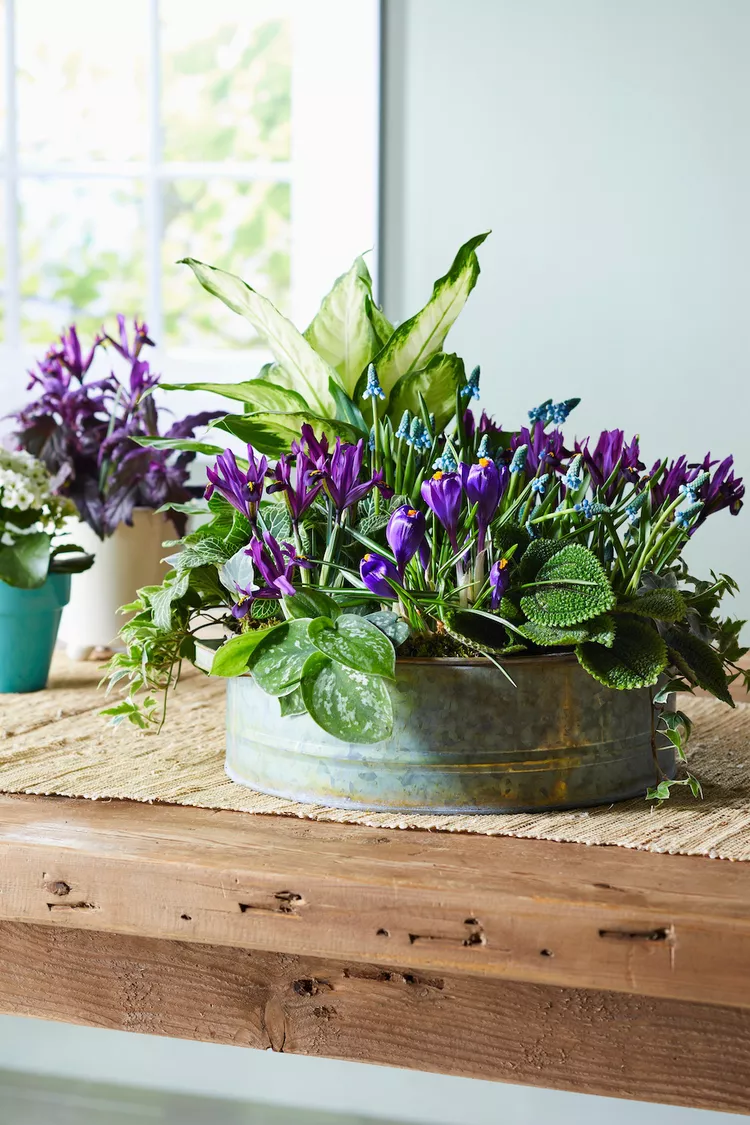- Working Time: 30 minutes
- Total Time: 30 minutes
- Skill Level: Kid-friendly
An indoor dish garden is an opportunity to grow a group of plants in a single shallow container that’s ideal for a tabletop or windowsill. Start with small houseplants and a container you have on hand to make this a more budget-friendly project. Tuck a few prechilled (i.e. forced, sprouted, and ready-to-grow) spring-flowering bulbs into the mix for cheery splashes of color.
Prechilled bulbs, widely available from mail-order nurseries and local garden centers in late winter and early spring, can be moved outdoors and into the garden after their blooms fade. Toss a handful of fertilizer into their planting holes, and they’ll likely flower again the following spring. You can either leave the houseplants in the dish garden, or repot them into individual containers again after you've removed the bulbs.
For this dish garden, white-variegated houseplants give the grouping a unified look. We choseDieffenbachia ‘Camille’, silver pothos, ‘Mini Adam’ English ivy (Hedera helix), ‘Moon Valley’ pilea, and Fittonia ‘Mini White’. Grape hyacinth, Dutch iris. and crocus in shades of purple and blue were our bulbs of choice because they stay on the shorter side, in proportion with a tabletop garden.
All of these plants thrive in the medium light of an east- or west-facing window. When shopping for houseplants, read plant labels and group your selections according to the level of light where you want to grow them. Plants receive low light when placed near a north or northeast window, high or bright light in a south or southwest window. Choose houseplants with similar needs for water, too.
To hold all these plants, we used a roomy metal tray as a decorative cachepot and fitted it with a plastic pot liner with a few holes for drainage. Make sure to pour off any excess water that may collect in a cachepot to avoid rotted roots.
What You'll Need
Equipment / Tools
- 1 awl
Materials
- 1 12-inch clear plastic pot liner
- 1 12x3-inch shallow pot or tray
- 5 small houseplants
- 3 types of pre-chilled bulbs
- 1 bag potting mix
- bark pieces and preserved moss
- 1 large cork saucer
Instructions
-
Place Liner in Pot
Use an awl to poke a few small holes through the pot liner to allow water drainage. Place the liner in your cachepot and fill halfway up with potting mix.
-
Arrange Houseplants
Remove the houseplants and bulbs from their nursery pots. Place the tallest plants at the back or off to one side. Place the shortest and trailing plants at the front of the container, with growing room in between them.
-
Add Bulbs
Tuck the bulbs among the plants. Place them wherever you feel they fit best. This completes an arrangement that highlights each plant.
-
Add Potting Mix and Moss
Fill in between the plantings with potting mix as needed. Cover bare soil with bits of bark and preserved moss. This adds texture and interest to the arrangement.
-
Set Container on Cork Saucer
Protect the surface beneath your dish garden from potential moisture damage. You can do this by setting the container on a cork saucer. Place on any surface for a touch of nature indoors.




















